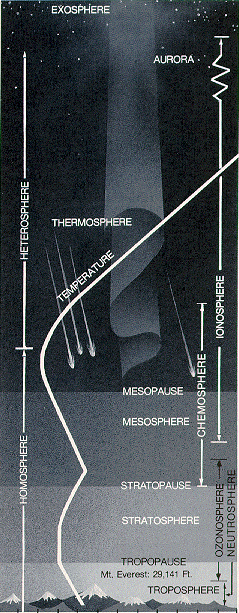 |
|||||
| Home | Research | For Teachers | HISTORY Level 1 Level 2 Level 3 |
PRINCIPLES Level 1 Level 2 Level 3 |
CAREER Level 1 Level 2 Level 3 |
| Gallery | Hot Links | What's New! | |||
| Web Administration and Tools | |||||
 |
|||||
| Home | Research | For Teachers | HISTORY Level 1 Level 2 Level 3 |
PRINCIPLES Level 1 Level 2 Level 3 |
CAREER Level 1 Level 2 Level 3 |
| Gallery | Hot Links | What's New! | |||
| Web Administration and Tools | |||||
![]()

At the end of this block of study, you should be able to:
![]() Describe the composition of the atmosphere.
Describe the composition of the atmosphere.
![]() Describe why air has weight and how this is related to
Describe why air has weight and how this is related to
atmospheric pressure.
![]() Describe how changes in air temperature affect
Describe how changes in air temperature affect
atmospheric pressure and density.
![]() Define relative humidity.
Define relative humidity.
![]() Convert temperatures between the Fahrenheit and
Convert temperatures between the Fahrenheit and
the Celsius scales.
The atmosphere is composed of a mixture of gases. Nitrogen is by far the largest component of air, accounting for 78 percent; the next largest component is oxygen which consists of 21 percent. The remainder consists of small portions of other gases. All gases, regardless of where they are found, have certain characteristics such as weight, density, temperature, pressure, and mass. To understand how an airplane flies within the atmosphere, you must first understand some of the features of the atmosphere.
| Section 2.1 - WEIGHT | |
| Section 2.2 - DENSITY | |
| Section 2.3 - PRESSURE | |
| Section 2.4 - HUMIDITY | |
| Section 2.5 - TEMPERATURE | |
| Section 2.6 - REVIEW EXERCISE |
Send all comments to ![]() aeromaster@eng.fiu.edu
aeromaster@eng.fiu.edu
© 1995-98 ALLSTAR Network. All rights reserved worldwide.
| Funded in part by | From Civil Air Patrol Educational Materials |
Updated: February 23, 1999